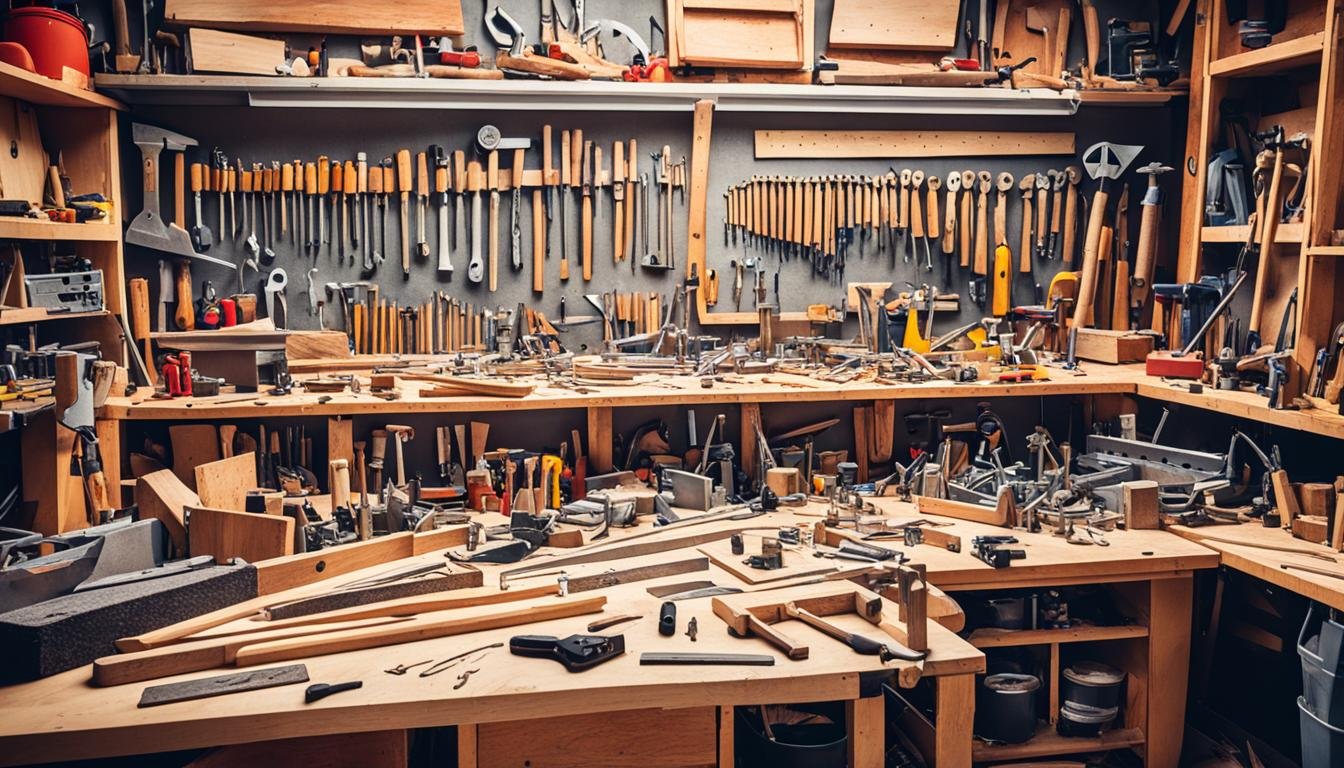
Woodworking is a timeless craft that allows us to unleash our creativity and create beautiful objects from humble pieces of wood. Whether you’re a complete beginner or have some experience under your belt, having the right tools is essential to take your woodworking skills to new heights.
In this beginner’s guide, we will explore the woodworking essentials that every aspiring woodworker should have in their toolkit. From hand tools to power tools and everything in between, we’ve got you covered. So, grab your apron and let’s dive into the world of woodworking!
Key Takeaways:
- Woodworking is a versatile and rewarding hobby that allows you to create beautiful and functional objects using wood.
- Having the right tools is essential for beginners to build a solid foundation in woodworking.
- We will explore essential hand tools, power tools, and other accessories that every beginner woodworker should have.
- By starting with the essentials and gradually expanding your collection, you can enhance your woodworking capabilities.
- Remember to prioritize safety and start with simple projects before taking on more complex ones.
Essential Hand Tools for Woodworking
Hand tools play a crucial role in woodworking as they allow for greater control and precision. As beginner woodworkers, it’s important to invest in the right tools that will help you get started and build a solid foundation for your woodworking journey. Here are some essential hand tools that every beginner should have:
1. Hand Saws
Hand saws are indispensable woodworking tools for cutting wood. They come in various types, such as crosscut saws, rip saws, and dovetail saws, and each serves a specific purpose. Crosscut saws are perfect for cutting wood across the grain, while rip saws are designed for cutting with the grain. Dovetail saws are ideal for making precise joinery cuts.
2. Planes
Planes are essential for smoothing and shaping wooden surfaces. They allow you to remove unevenness and create flat and straight surfaces. There are different types of planes, including block planes, jack planes, and smoothing planes. Each plane serves a specific purpose, so having a couple of different planes in your toolbox will give you more versatility.
3. Chisels
Chisels are versatile tools that help in shaping and refining wood. They are used for making precise cuts, cleaning up mortises, and carving intricate details. A set of chisels with different sizes will allow you to tackle a wide range of woodworking projects.
4. Files
Files are essential for shaping and smoothing wood. They are useful for removing rough edges, making bevels, and refining curves. Having a variety of files with different tooth patterns will give you more flexibility in achieving the desired shape and finish.
5. Woodworking Mallet
A woodworking mallet is a tool used to strike chisels and other woodworking tools. It provides controlled force and helps in driving the tool into the wood without damaging it. A wooden or rubber mallet is preferred over a metal hammer as it reduces the risk of marring the workpiece.
| Tool | Description |
|---|---|
| Hand Saws | Used for cutting wood across or with the grain |
| Planes | Essential for smoothing and shaping wooden surfaces |
| Chisels | Used for making precise cuts and refining wood |
| Files | Helpful in shaping and smoothing wood |
| Woodworking Mallet | Used to strike chisels and woodworking tools |
Having these essential hand tools in your woodworking arsenal will provide you with the necessary foundation to bring your woodworking projects to life. Remember to choose high-quality tools and maintain them properly to ensure their longevity and performance.
Power Tools for Woodworking
Power tools can significantly speed up your woodworking projects and provide greater efficiency. When it comes to woodworking power tools, there are several essential tools that every beginner should consider adding to their workshop. These power tools will not only enhance your woodworking capabilities but also allow you to tackle a wide range of projects with ease.
Circular Saw
A circular saw is a versatile and indispensable tool in any woodworker’s arsenal. It is perfect for making straight cuts on different types of wood, plywood, and other sheet materials. With the right blade, a circular saw can also be used for cutting bevels and angles. It is a powerful tool that allows for quick and accurate cutting, making it essential for various woodworking projects.
Jigsaw
If you’re looking to make intricate and curved cuts, a jigsaw is the power tool you need. With its maneuverability and finesse, a jigsaw enables you to cut curves, shapes, and patterns effortlessly. It is particularly useful for projects that require detailed work, such as creating intricate designs or cutting out openings.
Compound Miter Saw
A compound miter saw is a must-have for making precise angled cuts in woodworking. This versatile tool allows you to easily make beveled cuts and compound miter cuts. It is perfect for projects that require accurate trimming, molding installation, and creating frames or furniture with angled corners.
Table Saw
A table saw is a fundamental power tool for any woodworking enthusiast. It is designed to make a variety of cuts on larger workpieces with accuracy and control. A table saw is essential for rip cuts, crosscuts, bevel cuts, and even joinery cuts. With the right accessories and adjustments, it can handle various woodworking tasks, making it an indispensable tool in any workshop.
Bandsaw
When it comes to cutting curves and intricate shapes, a bandsaw is the tool of choice. This versatile power tool can make precise and intricate cuts in different types of wood and other materials. It is especially valuable for projects that involve sculpting, resawing lumber, or creating detailed shapes and patterns.
By incorporating these woodworking power tools into your workshop, you’ll be equipped to take on a wide range of projects with precision and efficiency. Each tool serves a specific purpose and offers unique capabilities in the world of woodworking. Whether you’re a beginner or an experienced woodworker, investing in these essential power tools will take your craft to the next level.
Training
Training is an essential aspect of mastering any skill, and woodworking is no exception. Whether you are a novice or experienced, the right training can enhance your woodworking abilities and take your craft to new heights. In the age of social media, there are countless resources available for aspiring woodworkers. One exciting trend is the use of hashtags like #learnwoodworking, #craftingwithwood, and #woodworking101 to connect enthusiasts worldwide and share knowledge.
The internet provides a wealth of information on woodworking, from basic techniques to expert-level projects. YouTube channels and online tutorials can teach you everything you need to know, enabling you to learn at your own pace and in the comfort of your own space. Additionally, many woodworking forums and websites offer free plans, tips, and tricks, allowing you to expand your skills and knowledge.
There is an example of an excellent woodworker creator Ted Mcgrath
Other Essential Tools and Accessories
In addition to hand tools and power tools, there are several other essential tools and accessories that every beginner woodworker should have. These accessories will enhance your woodworking experience and make your projects more precise and professional-looking.
Clamps
Clamps are indispensable tools in woodworking as they provide a secure grip on workpieces during assembly, gluing, and drying. They help to keep your projects in place and ensure precise alignment. Whether you’re working on small or large projects, having a few clamps of different sizes is essential.
Measuring Tools
Accurate measurements are crucial in woodworking to ensure the proper fitting and alignment of components. Some essential measuring tools include:
- A tape measure for taking length, width, and height measurements.
- A carpenter’s square for ensuring square and angled cuts.
These tools will help you achieve precision and accuracy in your woodworking projects, resulting in professional-quality outcomes.
Sanders
Sanding is an essential step in woodworking to achieve smooth and refined surfaces. Sanders help in removing rough edges, leveling uneven surfaces, and preparing the wood for finishing. Some common types of sanders used in woodworking include:
- Orbital sanders
- Belt sanders
- Random orbital sanders
Depending on your project requirements, having one or more sanders will make the sanding process faster and more efficient.
Drills
Drills are versatile power tools that are essential for drilling holes and driving screws in woodworking. They come in different types, such as corded drills and cordless drills, and offer various speed and torque settings. Having a drill with a selection of drill bits and screwdriver bits will allow you to tackle a wide range of woodworking tasks.
Table
| Tool/Accessory | Brief Description |
|---|---|
| Clamps | Used for securing workpieces during assembly and gluing. |
| Measuring Tools | Includes a tape measure and carpenter’s square for accurate measurements. |
| Sanders | Used for smoothing and refining wood surfaces. |
| Drills | Essential for drilling holes and driving screws in woodworking. |
These tools and accessories will greatly enhance your woodworking capabilities, making your projects more enjoyable and professional-looking.
Conclusion
Woodworking is a journey that brings out your creativity and allows you to craft functional pieces from wood. With the right tools and equipment, your woodworking projects will be both satisfying and successful. Starting with the essential hand tools and power tools mentioned in this guide will give you a solid foundation to begin your woodworking journey.
As you gain experience, don’t be afraid to expand your collection and try new techniques. Remember to prioritize safety by wearing protective gear and following proper instructions. Start with simpler projects to build your skills and confidence, and gradually take on more complex challenges. Woodworking is a skill that grows with practice and patience.
Explore woodworking blogs, forums, and tutorials for valuable tips and inspiration. Engaging with fellow woodworkers will provide a wealth of knowledge and guidance along the way. Don’t hesitate to ask for advice and share your own experiences. Woodworking is a community that is always ready to help and support each other.
Enjoy the process of transforming raw wood into beautiful creations. Embrace the imperfections and learn from each project. Whether you’re making furniture, toys, or decorative items, woodworking allows you to leave a lasting legacy through your craftsmanship. So, dive into the world of woodworking and let your creativity soar!
References to see :
FAQ
What are the essential hand tools for woodworking?
Essential hand tools for woodworking include hand saws, planes, chisels, files, and a woodworking mallet. Hand saws are used for cutting wood, while planes are used for smoothing and shaping surfaces. Chisels and files help in shaping and refining wood, and a woodworking mallet is used to strike chisels and other tools.
What are the essential power tools for woodworking?
Essential power tools for woodworking include a circular saw, jigsaw, compound miter saw, table saw, and bandsaw. A circular saw is versatile and great for making straight cuts, while a jigsaw is ideal for making intricate and curved cuts. A compound miter saw is perfect for making angled cuts, and a table saw is essential for making a variety of cuts on larger workpieces. A bandsaw is excellent for cutting curves and intricate shapes.
What are some other essential tools and accessories for woodworking?
Other essential tools and accessories for woodworking include clamps for securing workpieces, measuring tools such as a tape measure and carpenter’s square for accurate measurements, sanders for smoothing surfaces, and drills for drilling holes and driving screws.
How can I start woodworking as a beginner?
As a beginner, start by acquiring the essential hand tools and power tools mentioned in this guide. Begin with simple projects and gradually expand your woodworking skills and collection of tools as you gain more experience. Remember to prioritize safety and always enjoy the process of exploring the world of woodworking.
Reading Resources (free books)
Source Links
- https://www.yorksaw.com/beginners-guide-to-must-have-tools-for-woodworking/
- https://www.thecrucible.org/guides/woodworking/
- https://www.americanrotary.com/blog/woodworking-tools-for-beginners/
Disclosure: This post contains affiliate links. If you make a purchase through these links, I may earn a commission at no additional cost to you. We only recommend products or services that I personally use and believe will add value to my audience. Your support helps keep this content free for everyone. Thank you for your support!
The Baffls Team (info@baffls.com)
Follow Us on https://www.Baffls.com (Facebook – Twitter/X)
#ExploreWoodworking #CraftingBeginners #WoodworkingEssentials
Disclosure: This post contains affiliate links. If you make a purchase through these links, I may earn a commission at no additional cost to you. We only recommend products or services that I personally use and believe will add value to my audience. Your support helps keep this content free for everyone. Thank you for your support!
Prices and discounts noted at the time of publication Friday March 12, 2024. They may have been changed without notice by the retailer at the time you view this page














Nice post. I was checking constantly this blog and I am impressed!
Very helpful information specially the last part 🙂 I care for such information much.
I was looking for this certain information for
a very long time. Thank you and good luck.
It’s a pleasure to help you.Thanks to continue to follow us!
Hi to all, how is the whole thing, I think every one is
getting more from this web page, and your views are fastidious
for new people.